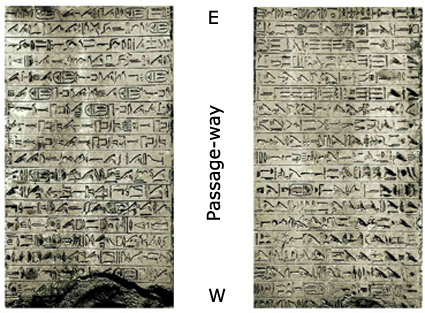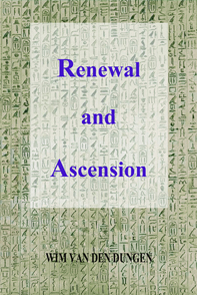The
Pyramid Texts of UNAS

by Wim
van den Dungen
Burial-Chamber
l
Antechamber
l
Corridor l
Serdab
introduction
l
English text
l plan
of the tomb l
commentary
PASSAGE-WAY

OFFERING
OF OFFERINGS
TO THE AKHET
Sethe's Edition
l
Central Plan
Overall textual
distributions :
It is possible to view the North & South Walls of the passage-way as
prolongations of the two main themes of the burial-chamber : offering &
rejuvenation. These two walls reflect the general characteristics of the North
and South walls of the burial-chamber, the latter being experiental, the former
liturgical. The direction of the signs underlines the West to East movement
already indicated by the texts of the burial-chamber.
The North Wall Offering Liturgy formally "ends" with the "reversion of
offerings" (199) followed by the libation, purification & censing rituals
repeated a few times in the Offering Liturgy (were they serve to separate the
sections of the ceremony).
The South-to-East texts culminate in the "smashing of the red jars", symbolizing
the end of the forces of opposition and inertia (Seth) and allowing the divine
king to proceed and fly up to Nut and merge with Min at the doors of the horizon
(the antechamber).
Structural parts :
►North
1. Ending the Offering Liturgy
With the "reversion of offerings" is meant the fact that the offerings,
returning what is received from the deities, are actually consumed. The libation, purification and incense rituals -met before at the beginning of
the Offering Liturgy on the North Wall- culminate in the affirmation of
the two registers of the Eye of Horus, namely as "incense" and as "Eye of
Horus", i.e. as material vehicle for the Ka and as standard of offering. The Eye
of Horus is therefore the ultimate symbol for the Lunar side of the spiritual
equation at work in Egyptian religion.
►South
2. Making way for the Akhet
Besides rejuvenation, the Duat leads to the Eastern Akhet, the place of the
deities and the ultimate transformation of the Ba into an Akh, of the soul into
a spirit. After 12 hours, the Sun dawns anew. At midnight (cf. 6th Hour of the
Duat), encircled by darkness, Osiris King Unas united with Atum and his First
Time. This rejuvenation is carried through the next 6 hours and finds its final
magnificent triumph in the regal appearance of the new, fragile light of dawn.
The soul of Unas leaves the Duat to be transformed in the horizon. This is
precisely what the South Wall indicates. Because of the Eye of Horus, the king
is strong and his enemies fear him. He breaks away from them. Next, he
escapes Osiris as a sacred falcon, for he stands high up, far above his dark
kingdom. In the East, the Unique One, who is in the king, goes forth. The
king stands at the doors of the horizon.
Comments
:
The texts of the passage-way bring out the essentials of both Ka & Ba aspects of
the Duat, i.e. offering & rejuvenation.
To offer properly, purify by water and incense and give body to the Kas of the
offerings by bringing them into the gravitational field of the Eye of Horus,
i.e. by affirming, through sacred speech, the analogy between each and every
offering and the
Wedjat. To possess the Eye of Horus, is to be
in constant touch with the power of restoration & health. The Eye is then a
highy synthetic symbol. It also points to the fact of a son becoming greater
than his father, a theme common in
sapiental
literature (cf.
Ptahhotep). The Lunar connection invites us to end strife (the
vindication of Horus) and heal the Earth (the body of Osiris). Thus a new cycle
of fertility may start (cf.
Osiris and
Nun,
the mythical source of the inundation timed by means of Sirius, i.e. Isis).
After rejuvenation, the divine king leaves Horus behind and goes to Nut, his
sky-mother. In fact, his Ba stands at the threshold of the horizon, and a great
potential is seen in him. This "Unique One in You" is the transformed Ba, the
divine Akh of the king thematized in the antechamber. There the name of the king
"comes into being among the gods".
|

![]()
